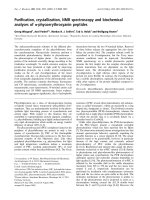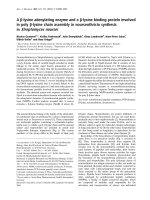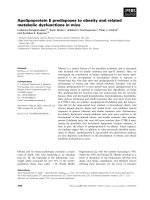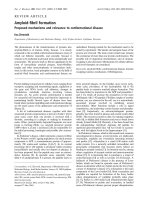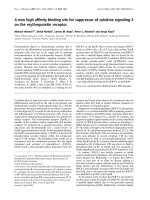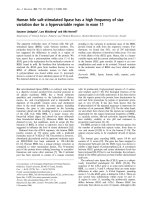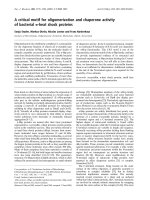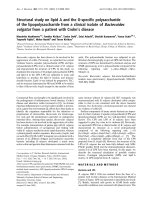Báo cáo y học: " Returning home: forced conscription, reintegration, and mental health status of former abductees of the Lord''''s Resistance Army in northern Uganda" pps
Bạn đang xem bản rút gọn của tài liệu. Xem và tải ngay bản đầy đủ của tài liệu tại đây (933.48 KB, 14 trang )
BioMed Central
Page 1 of 14
(page number not for citation purposes)
BMC Psychiatry
Open Access
Research article
Returning home: forced conscription, reintegration, and mental
health status of former abductees of the Lord's Resistance Army in
northern Uganda
Phuong N Pham*
†1,2
, Patrick Vinck
†1,2
and Eric Stover
3
Address:
1
Human Rights Center, University of California, Berkeley, Berkeley, CA, USA,
2
Payson Center for International Development, Tulane
University, New Orleans, LA, USA and
3
Human Rights Center, School of Public Health, and School of Law, University of California, Berkeley,
Berkeley, CA, USA
Email: Phuong N Pham* - ; Patrick Vinck - ; Eric Stover -
* Corresponding author †Equal contributors
Abstract
Background: Since the late 1980s, the Lord's Resistance Army (LRA), a spiritualist rebel group in
northern Uganda, has killed and mutilated thousands of civilians and abducted an estimated 52,000 to
75,000 people to serve as soldiers, porters, and sex slaves for its commanders. This study examines the
types of violence to which former abductees have been exposed and the extent to which these acts have
affected their psychological well-being.
Methods: This is a cross-sectional study of 2,875 individuals selected through a multi-stage stratified
cluster sampling design conducted in 8 districts of northern Uganda. Multivariate logistic regressions were
performed with symptoms for Post-traumatic Stress Disorder (PTSD) and depression as the main
outcome measures.
Results: One-third of the respondents (33%) self-reported having experienced abduction (49% among the
Acholi, the largest tribal group in northern Uganda). Over half (56%) of all the respondents and over two-
thirds of those who experienced abduction met the criteria for symptoms of post-traumatic stress
disorder (PTSD). Multivariate analysis shows that several factors increased the risk of former LRA
abductees developing symptoms of PTSD. These factors included gender (females were more susceptible
than males), being a member of the Acholi ethnic group, participating in or witnessing a cumulative number
of traumatic events, and encountering difficulties re-integrating into communities after abduction. Factors
associated with increased risk of meeting criteria for symptoms of depression included older age of males
at the time of abduction, lower score on social relationship scale, high incidence of general traumatic event
exposure, high incidence of forced acts of violence, and problems reintegrating into communities after
abduction.
Conclusion: Abduction and forced conscription of civilians has affected the psychological well-being of a
significant number of northern Ugandans. The sources of psychological trauma are multiple, ranging from
witnessing to being forced to commit violent acts, and compounded by prolonged exposure to violence,
often for months or years. Community-based mental health care services and reintegration programs are
needed to facilitate the reintegration of former abductees back into their communities.
Published: 16 May 2009
BMC Psychiatry 2009, 9:23 doi:10.1186/1471-244X-9-23
Received: 26 November 2008
Accepted: 16 May 2009
This article is available from: />© 2009 Pham et al; licensee BioMed Central Ltd.
This is an Open Access article distributed under the terms of the Creative Commons Attribution License ( />),
which permits unrestricted use, distribution, and reproduction in any medium, provided the original work is properly cited.
BMC Psychiatry 2009, 9:23 />Page 2 of 14
(page number not for citation purposes)
Background
Twenty-one years of war, destruction, and the displace-
ment of over 1.5 million people have turned northern
Uganda into a humanitarian disaster. One of the principal
belligerents in the conflict has been the Lord's Resistance
Army (LRA), a spiritualist rebel group that has killed and
mutilated thousands of civilians and abducted an esti-
mated 52,000 to 75,000 children and adults to serve as
soldiers, porters, and sex slaves for its commanders [1]. In
response, the International Criminal Court (ICC) issued
warrants of arrest, on 13 October, 2005, against LRA
leader Joseph Kony and four of his top commanders for
crimes against humanity and war crimes, including the
forced conscription of children [2]. Within weeks, the LRA
withdrew its forces to the southern Sudan and then
crossed the Nile, assembling in Garamba National Park in
the Democratic Republic of Congo. In the summer of
2006, peace talks between the Government of Uganda
and the LRA commenced in Juba, Sudan but collapsed
eighteen months later when Kony refused to sign a final
peace agreement. By February 2009, hundreds of thou-
sands of Ugandans remained in displacement camps
throughout the North and, in eastern Congo, the LRA
rebels and joint Ugandan-Congolese troops were engaged
in armed skirmishes.
While abduction of children and youth into regular and
rebel armies has been a common feature of recent armed
conflicts (Sri Lanka, Nepal, Angola, Mozambique, Sierra
Leone, Liberia, Uganda, Burma), little is known about the
process of reintegrating former abductees back into their
communities [3]. Until early 2007, community and inter-
national humanitarian organizations in northern Uganda
had operated 12 reception centers for LRA abductees who
were either captured in battle or managed to flee their cap-
tors [1,4-6]. Upon arrival, former abductees were given a
medical exam and treated for diseases and other ailments.
Those suffering from war wounds were sent to hospitals in
Gulu and Kampala. Most returnees stayed at the centers
for two to six weeks were the participated in a range of
activities, including counseling, music and dance, sports,
and vocational training. During that time, staff members
attempt to trace the whereabouts of their parents and rel-
atives and, if successful, the former abductees would be
reunited with their parents or other relatives.
To understand how abduction and the process of reinte-
gration had affected former LRA combatants we analyzed
a cross-sectional survey that was conducted in eight dis-
tricts of northern Uganda between March and June 2007.
Methods
Survey Sites and Sample Selection
Study participants were Ugandan adults (18 years of age
or older) randomly selected using a multi-stage sampling
strategy. The Committee for Protection of Human Sub-
jects at Tulane University and University of California,
Berkeley, and northern Uganda local government officials
approved the research protocol. No incentive was pro-
vided to the survey participants. The districts were selected
to represent a variety of ethnic groups (Acholi, Iteso, and
Langi) and exposure to the armed conflict (Figure 1). The
resulting minimum sample size–320 individuals for each
district–was determined using the difference in propor-
tion formula. The sample size was adjusted for stratifica-
tion and design effect due to cluster sampling and missing
responses. The assumed level of precision was 10% with
80% power. Within each district, camps for internally dis-
placed people were randomly selected using a sampling
technique proportionate to population size. In some
cases, residents of the camps had recently moved to new
settlement sites closer to their original villages. In order to
capture this population, we randomly selected one new
settlement site for each of the selected camps where pop-
ulation movement had taken place, based on the database
provided by the World Food Programme (WFP) and the
United Nations High Commission for Refugees
(UNHCR). In areas where the population was never dis-
placed or had returned to live in villages, sub-counties
were first sampled using a sampling technique propor-
tionate to population size, then parishes and then vil-
lages. In the camps and villages, interviewers were
assigned to zones of approximately equal size where they
selected every other household in a randomly chosen
direction. A household was defined as a group of people
normally sleeping under the same roof and eating
together. In each household, interviewers randomly
selected one adult respondent, of the same gender as the
interviewer, from a list of all eligible adults. Three
attempts were made to contact a household or individual.
Three teams of eight to 16 local university students or
graduates with experience in survey work participated in a
week-long training to familiarize themselves with the
standardized pre-coded open-ended questionnaire, inter-
view techniques, and selection process for respondents.
The teams were composed of equal numbers of men and
women, represented the ethnic group of the area under
study and were fluent in the local language. The training
included a pilot survey in non-sampled sites. Data were
collected using Personal Digital Assistants (PDA) with
integrated Global Positioning System (GPS). The inter-
viewers attended an additional three day of training on
the use of the PDA.
Interviewers approached a total of 4,455 households and
2,875 individuals were ultimately interviewed. One third
(35%) of the households was replaced by the next selected
household either because the household was empty and
no one could be contacted after three attempts (64%),
BMC Psychiatry 2009, 9:23 />Page 3 of 14
(page number not for citation purposes)
because no one was eligible in the household (no one 18
years of age or older (24%), or because they refused to
participate (12%). Within the selected households, one
individual was randomly selected. If that person could not
participate, another respondent within the same house-
hold was selected. In total, 20 of the selected individuals
had to be replaced either because they were absent or
could not be contacted after three attempts (78%) or
because they refused to participate (22%). Two interviews
were conducted mistakenly with individuals aged below
18 years old and were not included in the analysis. Eleven
interviews were not completed but the completed
responses are nevertheless included in the analysis. The
final sample size for the eight districts was 2,875 individ-
uals in 38 camps, 21 new sites, 59 villages, and nine
municipalities or town councils. The sample was distrib-
uted as follow (by district): Amuru: 347; Gulu: 335; Kit-
gum: 370; Pader: 352; Lira: 365; Oyam: 357; Amuria: 394;
Soroti: 355.
Research Instruments and Data Entry
The survey instrument covered 15 topics and was trans-
lated into the three local languages. Back-translation and
consultation with local experts was used to ensure the
quality of the translation. The questionnaire was field
tested and validated in non-participating sites and mock
interviews were organized during the training of the inter-
viewers.
Response options were provided to the interviewer but
not read to the participant unless otherwise indicated. An
"other" category was available to record responses when
necessary or when the interviewers were unsure of the
appropriate response option; it was recoded during anal-
ysis. Each evening the data were synchronized with a cen-
tral MySQL database and records were manually checked
for errors. One-on-one interviews were conducted anony-
mously in a confidential setting. Due to the sensitivity of
some of the questions, the interviewers were assigned to
Eight sampled districts in northern UgandaFigure 1
Eight sampled districts in northern Uganda.
!
!
!
!
!
!
Gulu
Kitgum
Pader
Oyam
Lira
Amuria
Soroti
Kampala
Adjumani
Masindi
Moyo
Apac
Dokolo
Kaberamaido
Amolatar
Kumi
Katakwi
LIRA DISTRICT (LANGO)
Sample size: n = 365
in 7 camps, 15 villages, 1 municipality
Lira
Gulu
Hoima
Soroti
Kitgum
Masindi
Amuru
Moroto
Kaabong
Kotido
Abim
Tanza nia
D.R.
Congo
Sudan
Kenya
Uganda
.
0255012.5
Kilometers
Map by Vinck P
Data Source:
Administrative limits
provided by CartONG
AMURU DISTRICT (ACHOLI)
Sample Size: n = 347
in 6 camps, 3 new sites
GULU DISTRICT (ACHOLI)
Sample Size: n = 335
in 4 camps, 4 new sites, 1 municipality
KITGUM DISTRICT (ACHOLI)
Sample Size: n = 370
in 5 camps, 6 new sites, 1 municipality
A c h o l i S u b r e g i o n
L a n g o S u b r e g i o n
T e s o S u b r e g i o n
PADER DISTRICT (ACHOLI)
Sample size: n = 352
in 5 camps, 4 new sites, 1 municipality
OYAM DISTRICT (LANGO)
Sample Size: n = 357
in 4 camps, 10 villages, 3 Town Council
SOROTI DISTRICT (TESO)
Sample Size: n = 355
in 2 camps, 29 villages, 1 municipality
AMURIA DISTRICT (TESO)
Sample size: n = 394
in 5 camps, 5 villages, 4 new sites,
1 municipality
BMC Psychiatry 2009, 9:23 />Page 4 of 14
(page number not for citation purposes)
same-sex respondents. Oral rather than written consent
was obtained due to the high illiteracy rate. The consent
form stressed confidentiality and respondents' names
were never recorded.
Measurements and Data Analysis
Digital data from the interviews were imported and ana-
lyzed using Statistical Package for Social Science (SPSS)
version 15.0. No weights were applied for the present
study. Scores for the 17-item PTSD Checklist-Civilian Ver-
sion (PCL-C), a measure of post-traumatic stress disorder,
and 15-item depression section of the Johns Hopkins
Depression Symptom Checklist (JHD) were computed to
assess symptoms of PTSD (cutoff score of 44) and depres-
sion (cutoff score of 42), respectively. The PCL-C, which
has been correlated with the Clinician-Administered
PTSD Scale (CAPS), uses simple language that eases the
process of translation and administration by nonclini-
cians to a population with low levels of education, and
has been shown to have good internal reliability and high
convergent validity in a wide variety of studies [7]. In
addition, the PCL-C and JHD had good reliability when
used by the investigators for this and prior study in
Uganda [8] and other countries including Rwanda and
Democratic Republic of Congo [9-11]. The estimated
Cronbach α (a measure of internal reliability) for the
three PCL-C symptom clusters in this study were as fol-
lows: re-experiencing, α = .875; avoidance, α = .860; and
hyperarousal, α = .850. The estimated Cronbach α for the
Depression Symptom checklist was α = .927.
Building on previous research in northern Uganda [8], we
developed a list of 33 items to measure exposure to vio-
lence and experience of abduction. The list does not rep-
resent all possible traumatic events but rather focuses on
commonly reported events. Building on measurements of
exposure to violence [12], four summative scales were
built to measure exposure to different categories of violent
events: direct victim of violence (e.g., being beaten); wit-
ness to violence; secondary exposure (e.g., loss of a family
member); and forced use of violence (e.g., being forced to
loot or beat someone).
We developed a measure of social relationship based on
three questions asking respondents to rank their relation-
ship with their family, friends and neighbors, and com-
munity in general on a five-point Likert scale. Principal
component analysis was used to analyze the three items
and resulted in one factor explaining 74.1% of the origi-
nal variance. A summative scale based on the original
items was therefore used as a measure of social relation-
ship (Cronbach α = .820).
We performed two separate multivariate logistic regres-
sions to examine factors associated with psychological
disorders (symptoms of PTSD and depression) among
respondents who reported experiencing abduction. The
predictors of greatest interest were exposure to violence
(summative scale by patterns of exposure), length of
abduction, going through a reception center, and social
relationship. Logistic regressions analysis allows one to
compute an odds ratio, an estimate of relative risk, and is
easier to interpret in exploring the complex relationships
presented in this paper. We performed both forward- and
backward-stepwise hierarchal regressions. Only the statis-
tically significant predictors were included in the final
models.
Results
General Characteristics of Abductees
Of 2,867 respondents with complete information on
experience of abduction, 946 (33%) reported they had
been abducted at one time or another during the course of
the 20-year conflict in northern Uganda. Among them,
46% stated that they had been abducted on two or more
occasions. In the Acholi sub-region, almost half of the
respondents (49%) stated that they had been abducted
compared to one-fifth (22%) in the Lango subregion and
one-tenth (11%) in the Teso subregion. This pattern is
reflected in the proportion of former abductees by ethnic
group since ethnic distribution roughly follows adminis-
trative limits.
As shown in Table 1 women accounted for 410 (43%) of
the 946 respondents who reported experiencing abduc-
tion. Males were more likely to have reported abduction
(OR
undj
= 1.44, 95% C.I. = 1.23, 1.68) compared to
females. The mean age of respondents who reported
abduction was 35.3 at the time of the survey (S.D. 13.51)
similar to the mean age of those who did not report
abduction (35.2). At the time of their first abduction,
respondents who were held in captivity averaged 25.8
years old (S.D. 13.57). A majority of those who were held
in captivity were in a committed relationship, either mar-
ried (71.8%) or in a partnership (3.6%). About a quarter
(24.8%) of the abducted had no education and 40% had
some but incomplete primary education. Formerly
abducted respondents further self-identified as Catholic
(70.2%) more frequently than non-abducted respondents
(57.8%).
Of those who reported abduction, 426 (45%) were held
for less than a day, 199 (21%) were held captive for one
to seven days, and 122 (13%) were held for between one
week and one month. One hundred and two respondents
(11%) were held for about one to six months and 97
(10%) for more than six months.
Exposure to Traumatic Events and War Crimes
Exposures to four categories of violent traumatic events
were assessed: direct victim (e.g., being beaten), witness to
violence, secondary exposure (e.g., loss of a family mem-
BMC Psychiatry 2009, 9:23 />Page 5 of 14
(page number not for citation purposes)
Table 1: Socio-Demographic Profile of Respondents by Abduction Status
All Not Abducted Abducted
n 2,867 1,921 946
(100%) (67%) (33%)
Gender (women) 1,417 1,007 410
(49.5%) (52.4%) (43.4%)
Mean Age 35.4 35.42 35.26
(S.D.) (14.35) (14.75 (13.51)
Mean Age at Abduction - - 25.84
(S.D.) - - (13.57)
Mean Income, Ugandan Shillings (S.D.) 33,426 35,804 28,701
(166,885) (199,492 (60,874)
Ethnicity Acholi 1,385 706 679
(48.3%) (36.7%) (71.8%)
Langi 712 633 79
(24.8%) (32.9%) (8.4%)
Teso 724 540 184
(25.2%) (28.1%) (19.5%)
Other 47 43 4
(1.6%) (2.2%) (0.4%)
Marital Status Single 373 265 108
(13.0%) (13.8%) (11.4%)
Married 2,070 1,391 679
(72.2%) (72.4%) (71.8%)
Partner 77 43 34
(2.7%) (2.2%) (3.6%)
Divorced 130 78 52
(4.5%) (4.1%) (5.5%)
Widowed 217 144 73
(7.6%) (7.5%) (7.7%)
Religion Catholic 1,771 1,108 663
(61.9%) (57.8%) (70.2%)
Protestant 802 580 222
(28.0%) (30.2%) (23.5%)
Born Again 227 177 50
(7.9%) (9.2%) (5.3%)
Other 63 53 10
(2.2%) (2.8%) (1.1%)
BMC Psychiatry 2009, 9:23 />Page 6 of 14
(page number not for citation purposes)
ber), and forced to use violence (e.g., being forced to loot
or beat someone). While exposure to violence was wide-
spread among respondents, former LRA abductees
reported higher level of exposure in all four categories (see
Table 2). The average cumulative number of reported
events within each category was also higher among former
LRA abductees (p-value < .001).
Returning home
Among those who were abducted less than one day, 67%
reported they were released by the LRA compared to 32%
of those held captive one to seven days and 18 among
those held captive between eight days and one month (see
Table 3). Conversely, 78% of those who were held for six
months or more escaped compared to 57% among those
captive one to seven days and 26% among those abducted
less than one day.
Thirteen percent of the respondents said they had spent
time in a reception center (see Table 3). One half (49%)
of those abducted for six months or more reported to a
reception center, compared to 2% of those abducted for a
day or less. Overall, men were 1.76 times more likely to
report that they had gone through a reception center than
women (OR = 1.77, 95% C.I. = 1.18, 2.63, p-value =
.005). However, the proportion of women going through
reception centers was higher than that of men, at 52%
compared to 47% (
χ
2
= 7.96, df = 1, p-value = 0.005).
Among those who went through a reception center, four
out of five (88%) reported that the reception center
helped them return to their communities, and almost half
reported that they received follow-up visits from reception
center staff.
Thirty-nine percent of former LRA abductees reported
problems upon returning to their home communities. In
addition, former LRA abductees who spent six or more
months with the rebels (68%) reported more problems
after returning home than those who stayed less time.
While physical and material concerns were frequently
mentioned ("health" and "injury": 18.9%; "loss of prop-
erty" and "goods": 10.6%), most of those who returned
reported mental and social problems ("mentally do not
feel well": 10.6%; "problems adjusting to life outside the
bush": 16.7%; "relationship problems with family":
10.8%).
Symptoms of PTSD and Depression Among Former
Abductees
Among respondents with a complete response to all items
on the PCL-C and the Johns Hopkins Symptom Checklist
who reported being abducted, 67% met the criteria for
symptoms of PTSD and 40% met the criteria for symptom
depression, compared to 51% and 25.9% respectively
among those who were not abducted (see Table 4). Com-
pared to non-abductees, those abducted were twice as
likely to meet the criteria for symptoms of PTSD (OR
undj
=
2.12, 95% C.I. = 1.81, 2.51) and symptoms of depression
(OR
undj
= 2.07, 95% C.I. = 1.75, 2.45). Respondents
abducted for six months or more frequently met the crite-
ria for symptoms of PTSD (80%) and symptoms of
depression (47%) than those abducted for shorter peri-
ods.
After statistically controlling for the effect of other varia-
bles by employing multivariate logistic regression, report-
ing symptoms of PTSD was associated with gender,
ethnicity, problems returning home, cumulative exposure
as a witness, and cumulative exposure to forced acts of
violence (see Table 5). Females were almost nine times
more likely to report symptoms of PTSD (OR
adj
= 8.84,
95% C.I. = 6.07, 12.88). Among abductees, Acholi were
three times more likely to meet symptom criteria for PTSD
than Iteso (OR
adj
= 3.05, 95% C.I. = 1.59, 5.87). Langi
were twice as likely to meet symptom criteria for PTSD
than Iteso (OR
adj
= 2.15, 95% C.I. = 1.05, 4.41). There was
no significant difference between Acholi and Langi
respondents. Cumulative number of traumatic events wit-
nessed (OR
adj
= 1.21, 95% C.I. = 1.10, 1.32) and cumula-
tive number of forced acts of violence (OR
adj
= 1.43, 95%
C.I. = 1.18, 1.74) among abductees were associated with
meeting criteria for symptoms of PTSD. Finally, former
abductees who reported difficulties coming home to their
community after abduction were nearly three times more
Education No schooling 698 473 225
(24.3%) (24.6%) (23.8%)
Some primary 1,073 691 382
(37.4%) (36.0%) (40.4%)
Completed primary 459 314 145
(16.0%) (16.3%) (15.3%)
Higher than primary 638 444 194
(22.2%) (23.1%) (20.5%)
Table 1: Socio-Demographic Profile of Respondents by Abduction Status (Continued)
BMC Psychiatry 2009, 9:23 />Page 7 of 14
(page number not for citation purposes)
Table 2: Exposure to Traumatic Events and War Crimes
All Not Abducted Abducted
Direct Violent Exposure
Was displaced 2,450 1,546 904
(85.4%) (80.4%) (95.6%)
Lost income due to conflict 2,441 1,562 879
(85.1%) (81.3%) (92.9%)
House destroyed 2,412 1,505 907
(84.1%) (78.3%) (95.9%)
Lost productive assets 2,387 1,490 897
(83.2%) (77.5%) (94.8%)
Was beaten by the LRA 587 57 540
(20.8%) (3.0%) (57.1%)
Was maimed by the LRA 173 23 150
(6.0%) (1.2%) (15.9%)
Was sexually violated 61 22 39
(2.1%) (1.1%) (4.1%)
Problem with UPDF 645 369 276
(22.5%) (19.2%) (29.2%)
Forced by LRA to walk long distances 833 89 744
(29.0%) (4.6%) (78.6%)
Forced by LRA to carry loads 727 26 701
(25.30%) (1.4%) (74.1%)
Mean Cumulative General Exposure (S.D.)* 4.94 4.16 6.61
(2.00) (1.79) (1.28)
Exposure as Witness
Witnessed an attack by LRA 1,988 1,114 874
(69.3%) (58.0%) (92.4%)
Witnessed LRA/UPDF fight 1,259 653 606
(43.9%) (34.0%) (64.1%)
Witnessed an abduction 1,812 935 877
(63.2%) (48.6%) (92.7%)
Witnessed s.o. beaten by LRA 1,531 718 813
(53.4%) (37.4%) (85.9%)
Witnessed s.o. beaten by UPDF 1,187 662 525
(41.4%) (34.4%) (55.5%)
Witnessed s.o. killed by the LRA 931 406 525
(32.5%) (21.1%) (55.5%)
Witnessed HH member killed by LRA 709 307 402
(24.7%) (16.0%) (42.5%)
BMC Psychiatry 2009, 9:23 />Page 8 of 14
(page number not for citation purposes)
Witnessed s.o. sexually violated by LRA 249 84 165
(8.7%) (4.4%) (17.4%)
Witnessed s.o. sexually violated by other 243 111 132
(8.5%) (5.8%) (14.0%)
Mean Cumulative Witness Exposure (S.D.)* 32.475.19
(2.57) (2.43) (1.86)
Secondary Exposure
At least 1 family member killed 2,115 1,272 843
(73.7%) (66.2%) (89.1%)
Spouse/Partner killed 88 53 35
(3.1%) (2.8%) (3.7%)
Mother killed 141 73 68
(4.9%) (3.8%) (7.2%)
Father killed 304 159 145
(10.6%) (8.3%) (15.3%)
Brother killed 870 466 404
(30.3%) (24.2%) (42.7%)
Sister killed 257 132 125
(9.0%) (6.9%) (13.2%)
Son killed 226 132 94
(7.9%) (6.9%) (9.9%)
Daughter killed 72 41 31
(2.5%) (2.1%) (3.3%)
Grandmother killed 74 48 26
(2.6%) (2.5%) (2.7%)
Grandfather killed 117 83 34
(4.1%) (4.3%) (3.6%)
Family member was abducted 1,106 582 524
(38.6%) (30.3%) (55.6%)
Mean Cumulative Secondary Exposure (S.D.) 1.15 0.93 1.61
(1.10) (1.04) (1.10)
Forced Acts of Violence During Captivity by the LRA
Forced to loot NA NA 353
(37.2%)
Forced to beat or injure someone NA NA 167
(17.6%)
Forced to kill someone NA NA 76
(7.6%)
Mean Cumulative Forced Acts of Violence (S.D.) NA NA 0.62
(0.92)
*p-value < .001 for difference in mean cumulative exposure between abducted and non-abducted people
Table 2: Exposure to Traumatic Events and War Crimes (Continued)
BMC Psychiatry 2009, 9:23 />Page 9 of 14
(page number not for citation purposes)
Table 3: Experiences Returning Home among Former Lord's Resistance Army Abductees
Abducted
< 1 day 1–7 days 8 days – < 1 month 1 – < 6 months > 6 months
Means of Return
Released by LRA 282 63 22 11 6
(67.0%) (32.0%) (18.3%) (11.2%) (6.3%)
Escaped 111 112 80 79 74
(26.4%) (56.9%) (66.7%) (80.6%) (77.9%)
Rescued by UPDF 26 22 17 8 14
(6.2%) (11.2%) (14.2%) (8.2%) (14.7%)
Other 2 0 1 0 1
(0.5%) (0.0%) (0.8%) (0.0%) (1.1%)
Went through Reception center 822 21 28 47
(1.9%) (11.0%) (17.2%) (27.7%) (48.5%)
Helped return in community 2 20 20 23 46
(25.0%) (90.9%) (95.2%) (82.1%) (97.9%)
Was visited by center's staff after return 1 10 14 13 23
(12.5%) (45.5%) (66.7%) (46.4%) (48.9%)
Had Problem Returning Home 104 74 67 60 66
(24.4%) (37.0%) (54.9%) (59.4%) (68.0%)
Type of Problems
Stigmatization 4 34 7 10 12
(4.0%) (4.20%) (11.30%) (16.7%) (18.2%)
"Mentally do not feel well" 10 8 8 5 7
(9.9%) (11.3%) (12.9%) (8.3%) (10.6%)
Problem with adjusting to life outside the bush 8 3 9 10 11
(7.9%) (4.2%) (14.5%) (16.7%) (16.7%)
Difficulty with school, work 9 7 4 7 13
(8.9%) (9.9%) (6.5%) (11.7%) (19.7%)
Relation problems, family 9 9 9 6 6
(8.9%) (12.7%) (14.5%) (10.0%) (9.1%)
Relations problems, friends/neighbors 6 3 8 4 3
(5.9%) (4.2%) (12.9%) (6.7%) (4.5%)
Health, injury 18 26 8 9 7
(17.8%) (36.6%) (12.9%) (15.0%) (10.6%)
Loss of property/goods 17 8 6 5 2
(16.8%) (11.3%) (9.7%) (8.3%) (3.0%)
Other 20 4 3 4 5
(19.8%) (5.6%) (4.8%) (6.7%) (7.6%)
BMC Psychiatry 2009, 9:23 />Page 10 of 14
(page number not for citation purposes)
likely to meet criteria for symptoms of PTSD at the time of
the survey (OR
adj
= 2.97, 95% C.I. = 2.09, 4.24).
Multivariate logistic regression analysis showed that meet-
ing symptoms of depression was associated with gender,
relationship with family, difficulties returning home,
cumulative direct violent traumatic exposure, and cumu-
lative exposure to forced acts of violence (see Table 5).
Interactions between age and gender were also significant.
Among abductees, women were twice as likely as men to
report symptoms of depression (OR
adj
= 2.11, 95% C.I. =
1.22, 3.63). Due to statistical interaction between age and
gender, each one-year increase in age is associated with
multiplicative increase in odds of having symptoms of
depression by 3% among men and decrease in odds of
having symptoms of depression by 2% among women.
This means that while male abductees may have an
increased risk of having symptoms of depression as they
age, the risk for female abductees may decrease with age.
Higher self-reported positive scores for abductees' rela-
tionships with their family, friends, and community were
associated with a decrease in odds of meeting the criteria
for symptoms of depression (OR
adj
= 0.90, 95% C.I. =
0.83, 0.97). Likewise, reported problems when returning
were positively associated with the odds of meeting the
criteria for symptoms of depression (OR
adj
= 2.24, 95%
C.I. = 1.63, 3.08). The cumulative number of general trau-
matic exposures (OR
adj
= 1.18, 95% C.I. = 1.03, 1.33) and
cumulative number of forced acts of violence (OR
adj
=
2.24, 95% C.I. = 1.63, 3.08) were associated with
increased odds of meeting the criteria for symptoms of
depression among abductees. The following variables
were not statistically associated with either symptoms of
PTSD or depression in the multivariate analyses described
Table 4: Psychosocial Well-being Among Former Lord's Resistance Army Abductees
Not Abducted Abducted Abducted
< 1 day 1–7 days 8 days – < 1 month 1 – < 6 months >6 months
Symptoms of Depression
Total 481 373 160 77 55 36 45
(25.9%) (40.4%) (38.6%) (39.5%) (47.0%) (35.3%) (47.4%)
Men 125 146 38 34 29 17 28
(14.0%) (27.8%) (20.0%) (28.8%) (35.8%) (24.6%) (41.2%)
Women 355 227 122 43 26 19 17
(36.8%) (57.3%) (54.7%) (55.8%) (72.2%) (57.6%) (63.0%)
Total Symptoms for PTSD
Total 938 613 259 126 83 70 75
(50.6%) (67.1%) (62.7%) (65.3%) (72.8%) (70.7%) (79.8%)
Men 306 274 73 57 51 42 51
(34.6%) (52.6%) (38.8%) (48.7%) (63.8%) (61.8%) (75.0%)
Women 630 338 185 69 32 28 24
(65.2%) (86.4%) (82.6%) (90.8%) (94.1%) (90.3%) (92.3%)
Cluster: Reexperiencing 1,351 763 334 161 108 79 81
(71.3%) (81.5%) (79.0%) (82.6%) (90.0%) (78.2%) (83.5%)
Cluster: Avoidance/numbing 861 563 233 118 77 62 73
(45.5%) (60.4%) (55.3%) (59.6%) (65.3%) (61.4%) (77.7%)
Cluster: Hyperarousal 1,079 676 299 141 87 75 74
(56.8%) (72.5%) (71.0%) (71.6%) (73.7%) (74.3%) (77.1%)
Relationship with family and
community, Mean (S.D.)
12.01 12.26 12.4 12.26 12.04 12.03 12.08
(2.01) (1.88) (1.78) (1.74) (1.94) (2.09) (2.19)
BMC Psychiatry 2009, 9:23 />Page 11 of 14
(page number not for citation purposes)
above: 1) length of abduction, 2) going through a recep-
tion center, 3) being married or in partnership relation-
ship.
Discussion
One-third of the respondents (33%) self-reported having
experienced abduction (49% among the Acholi). Our
findings further suggest that fewer former LRA abductees
passed through the reception centers before returning to
their home communities than had previously been
reported. This in turn suggests that the number of
abducted people in northern Uganda may have been
underestimated as the estimates were calculated based on
the number of children passing through the reception
centers [6,13].
Of those who reported abduction, 426 (45%) were held
for less than a day, 199 (21%) were held captive for one
to seven days and 122 (13%) were held for between one
week and one month. Our findings suggest that young
men are specifically selected for long-term conscription:
The average age at the time of abduction and the propor-
tion of women decreased with longer periods of abduc-
tion. This selection process is highlighted also by how
those abducted were returned: Over two thirds (67%) of
those held in captivity for less than one day were released
by the LRA. The LRA may have abducted as many people
as they could during a raid to help them carry stolen goods
and also enable them to select the fittest individuals for
their army.
The findings suggest LRA soldiers force conscripts to com-
mit violent acts such as killing, beating or looting, possi-
bly as a form of indoctrination ritual [1,5]. These practices
may force the recruit to violate their own moral principles
and to break from any form of social attachment, ulti-
mately making them more submissive and compliant to
the leadership [14]. As a result, civilians have paid a high
toll during the conflict, often at the hands of those forci-
bly recruited.
Based on the results, former LRA abductees confront a
range of problems when returning to their communities,
including psychological (e.g., "mentally do not feel well")
and social (e.g., relationship with family, community)
problems. Problems associated with returning home were
found to be statistically associated with symptoms of
PTSD and depression. However, because this is a cross-
sectional study, we cannot determine whether symptoms
of PTSD and/or depression led to problems associated
Table 5: Statistically Significant Associations of Socio-demographic and Exposure Characteristics with Symptoms of PTSD and
Depression
Symptoms of PTSD Symptoms of Depression
Independent Variables Adjusted OR p-value Adjusted OR p-value
(95% CI) (95% CI)
Gender
Female/Male 8.84 (6.07, 12.88) < 0.001 2.11 (1.22, 3.63) 0.007
Ethnicity
Acholi/Iteso 3.05 (1.59, 5.87) 0.001 NS NS
Langi/Iteso 2.15 (1.05, 4.41) 0.038 NS NS
Acholi/Langi 1.42 (0.94, 2.16) 0.098 NS NS
Acholi/Others 0.55 (0.65, 4.60) 0.578 NS NS
Relationship with Family and Community NS NS 0.90
(0.83, 0.97)
0.007
Reported Problem Coming Home 2.97 (2.09, 4.24) < 0.001 2.24 (1.63, 3.08) < 0.001
Cumulative General Traumatic Exposure NS NS 1.18 (1.03, 1.33) < 0.001
Cumulative Exposure as Witness 1.21 (1.10, 1.32) < 0.001 NS NS
Cumulative Forced Act of Violence 1.43 (1.18, 1.74) < 0.001 2.24 (1.63, 3.08) <0.001
Male* Age of Abduction NS NS 1.03 (1.01, 1.05) 0.001
Female*Age of Abduction NS NS 0.98 (0.95, 1.00) 0.035
Abbreviations: OR, odds ratio; CI, confidence interval; PTSD, post-traumatic stress disorder; NA = not applicable because variable was not retained
in the final model; UGS, Ugandan Shillings
Odds ratios are adjusted for the effect of other statistically significant variables in the model.
* other group comparison were examined but were also not statistically significant
BMC Psychiatry 2009, 9:23 />Page 12 of 14
(page number not for citation purposes)
with returning home or whether problems associated with
returning home elicited symptoms of PTSD and/or
depression. The study did not find any relationship
between going through the reception center and having
symptoms of PTSD and/or depression but found that
those who had better relationships with their family,
friends, and community were less likely to have symp-
toms of depression (OR
adj
= 0.90, 95% C.I. = 0.83, 0.97).
This supports several qualitative research studies con-
ducted in northern Uganda which found that family and
community acceptance and support are vital to psychoso-
cial well-being of former LRA abductees [15]. It shows the
value of reintegrating former abductees with their families
and developing programs to help them move ahead eco-
nomically and socially. At the same time, the study did
not find a significant association between social relation-
ships and symptoms of PTSD, suggesting that the reinte-
gration process alone is insufficient to address those
symptoms. Also the study did not find an association
between having attended a reception center and symp-
toms of PTSD and depression. However, going through a
reception centers was found to have helped the reintegra-
tion process.
The prevalence of those who met criteria for symptoms of
PTSD among former LRA abductees was high: over half of
all the respondents and over two-thirds of those who
experienced abduction met the criteria for symptoms of
PTSD (four out of five among those abducted six months
or more). Nevertheless, the overall prevalence of those
who met the criteria for symptoms of PTSD among former
LRA abductees is lower than suggested in earlier studies
[8]. This change may be due to significantly decreased lev-
els of violence since earlier assessments or because people
may have learned to cope with their symptoms. The prev-
alence of symptoms of depression was also high in our
sample, with nearly one third of the respondents and 40%
of those who experienced abduction meeting the criteria
for symptoms of depression (nearly half of those
abducted for six months or more).
Symptoms of PTSD were present at a higher rate among
individual LRA returnees who had witnessed and been
exposed to direct acts of violence. Symptoms of depres-
sion were more likely among individuals who had been
directly exposed to violence and forced to commit acts of
violence. Secondary exposure (e.g. direct exposure of fam-
ily members) was associated with neither symptoms of
PTSD nor symptoms of depression. This suggests that
beyond the "dose-effect" model linking increased expo-
sure to violence with an increase in psychological trauma,
[16-18] witnessing violence and being forced to commit
violence can also lead to increased psychological trauma,
as we have suggested in previous studies [8,9]. Finally, the
length of abduction was not found to be significantly
associated with symptoms of PTSD and depression. How-
ever, exposure to violence, including being forced to com-
mit acts of violence increase with length of abduction and
were found to be significantly associated with those symp-
toms.
Limitations
This study has several limitations. The sampling universe
for this study consisted of adults aged 18 or above residing
in eight districts in northern Uganda. The districts were
selected to represent the ethnic composition of the
affected population and exposure to the conflict. Children
at the time of the study and abductees who have not
returned were not included in the sample. Therefore, the
results cannot be generalized to all Ugandans but only
represent the adult population from which we sampled.
The study further relies on self-reported scales and
responses that may have been affected by social desirabil-
ity and recall errors. To minimize this we did not offer any
incentive to participate in the study and used a consent
form stressing the confidential and anonymous nature of
the interviews. Adapting the language and western con-
cepts used in measuring psychological trauma to non-
Western populations may result in trans-cultural errors.
However, we consulted with local experts and other
researchers during the development of our research
instrument, and we had successfully implemented a simi-
lar study in northern Uganda in 2005. The purpose of this
paper is not to be clinically precise (i.e., coming up with a
predictive model), but to obtain a greater understanding
of factors that are associated with mental health among
those who were formerly abducted by the LRA. We
assessed exposure to trauma asking respondents whether
they have been exposed to the events listed in Table 2.
These events were chosen based on our consultation and
prior research. [4,10,12]. These traumatic events do not
represent all the possible traumatic events but those that
were reported frequently. It may not meet all of the sub-
jective and objective components of Criterion A. Further-
more, we did not assess for functional impairment. We
used the PTSD Checklist-Civilian Version (PCL-C), a
measure of post-traumatic stress disorder, and 15-item
depression section of the Johns Hopkins Depression
Symptom Checklist (JHD). The use of standard scales to
measure the symptoms of psychological disorders such as
PTSD and depression has been widely debated. Critics
generally stress the lack of validity of those measurements
because they are applied in different cultural environment
and in conflict situations [19-21]. Those measures were
nevertheless included in our analysis because they are val-
idated [21-23] measures of psychological trauma outside
clinical diagnostic interviews and have been applied in
war-affected countries, such as the former Yugoslavia,
Rwanda, Algeria, Cambodia, and Ethiopia, among other
countries [8,9,17,24]. Nonetheless, the instruments were
BMC Psychiatry 2009, 9:23 />Page 13 of 14
(page number not for citation purposes)
not specifically validated for northern Uganda. In addi-
tion, we dichotomized the scores for the criteria for symp-
toms of PTSD and depression using two cut-off points:
symptoms of PTSD (cutoff score of 44) and depression
(cutoff score of 42). The two cut-off scores are chosen
because they yielded the most conservative estimates and
permitted us to conduct logistic regression. It is possible
that more respondents had symptoms of PTSD and
depression than reported. Finally, causal relationships
cannot be established because of the cross-sectional
design of this study. Further research will be needed to
assess these relationships.
Conclusion
We found high prevalence rates of symptoms of PTSD and
depression among former LRA abductees in northern
Uganda. The symptoms were associated with directly
experiencing violence, being forced to commit violent
acts, and/or witnessing violent acts. All of these symptoms
were more frequent among those held captive for longer
periods of time. We found that problems returning home
were associated with symptoms of PTSD and depression.
In addition, those who reported having better relations
with their family, friends, and community were less likely
to report symptoms of depression.
These findings have important implications for mental
health services and reintegration programs in northern
Uganda. This study corroborates other studies that found
family and community play an important role for the psy-
cho-social well being of former abductees [15]. Thus
addressing psychological trauma and helping former
abductees reunite with their family and community are
paramount to facilitating the return to their communities
of those held in captivity.
At the same time, improving the quality of life of former
abductees goes beyond psychological care and must
include an inclusive livelihood-based approach to
improve access to education and economic opportunities.
The approach should be aimed at the community as a
whole to decrease the level of stigmatization already expe-
rienced by some former LRA abductees [13,25,26].
Our study found that few former LRA abductees went
through reception centers. Even fewer received follow-up
visits by reception center staff that might have helped with
their reintegration. Going through a reception center was
not statistically associated with a decrease in symptoms of
depression or PTSD. This is not surprising because recep-
tion centers were not originally established to offer such
services. However, should a large influx of former LRA
abductees return to northern Uganda, reception centers
could provide these returnees with a safe place to stay as
they re-adjust to civilian life and are re-integrated with
their families and communities.
Competing interests
The authors declare that they have no competing interests.
Authors' contributions
PNP and PV designed the study, conducted the field study
in Uganda, and analyzed the data. PNP, PV, and ES inter-
preted the data and wrote the report. All authors read and
approved the final manuscript.
Acknowledgements
The research was supported by grants from the John D. and Catherine T.
MacArthur Foundation and Humanity United. The sponsors of the study
had no role in the design of the study, data collection, data analysis, data
interpretation or writing of the report.
We wish to thank our field surveyors and the survey respondents for taking
the time to share their views with us. We also would like to thank Drs. Har-
vey Weinstein and Janet Rice for their comments on the draft.
References
1. Human Rights Watch: Uprooted and Forgotten: Impunity and
Human Rights Abuses in Northern Uganda. Volume 17, No. 12
(A). New York, N.Y; 2005.
2. International Criminal Court: Warrant of Arrest unsealed against five
LRA Commanders, Press Release The Hague; 2005.
3. Machel G: The Impact of War on Children London: United Nations Chil-
dren's Fund, United Nations Development Fund for Women; New
York, N.Y; 2001.
4. Derluy I, Broekaert E, Schuyten G, et al.: Post-traumatic stress in
former Ugandan child soldiers. The Lancet 2004, 363:861-863.
5. De Temmerman E: Aboke Girls: Children Abducted in Northern Uganda
Kampala, Fountain Publishers; 2001.
6. Pham PN, Vinck P, Stover E: The Lord's Resistance Army and
Forced Conscription in Northern Uganda. Human Rights Quar-
terly 2008, 30(2):404-411.
7. Ruggiero KJ, Del Ben K, Scotti JR, et al.: Psychometric properties
of the PTSD Checklist-Civilian Version. Journal of Trauma Stress
2003, 16(5):495-502.
8. Vinck P, Pham PN, Stover E, et al.: Exposure to War Crimes and
Implications for Peace Building in Northern Uganda. Journal
of the American Medical Association 2007, 298(5):543-554.
9. Pham PN, Weinstein HM, Longman T: Trauma and PTSD: Their
Implication for Attitudes Towards Justice and Reconcilia-
tion. Journal of the American Medical Association 2004,
292(5):602-612.
10. Bayer CP, Klasen F, Adam H: Association of Trauma and PTSD
Symptoms With Openness to Reconciliation and Feelings of
Revenge Among Former Ugandan and Congolese Child Sol-
diers. Journal of the American Medical Association 2007,
298(5):555-559.
11. Roberts B, Kaducu FO, Browne J, et al.: Factors associated with
post-traumatic stress disorder and depression amongst
internally displaced persons in northern Uganda. BMC Psychi-
atry 2008, 8:38.
12. Vinck P: In the Eyes of Victims: Peace and Justice in Northern Uganda., in
International Development New Orleans, LA; Tulane University;
2006:175.
13. Annan J, Blattman C: Survey of War Affected Youth Kampala, United
Nation Children's Fund; 2006.
14. Amone-P'Olak K: Coping with Life in Rebel Captivity and the
Challenge of Reintegrating Formerly Abducted Boys in
Northern Uganda. Journal of Refugee Studies 2007, 20(4):641-661.
15. Corbin JN: Returning home: resettlement of formerly
abducted children in Northern Uganda. Disasters 2008,
32(2):316-335.
Publish with Bio Med Central and every
scientist can read your work free of charge
"BioMed Central will be the most significant development for
disseminating the results of biomedical research in our lifetime."
Sir Paul Nurse, Cancer Research UK
Your research papers will be:
available free of charge to the entire biomedical community
peer reviewed and published immediately upon acceptance
cited in PubMed and archived on PubMed Central
yours — you keep the copyright
Submit your manuscript here:
/>BioMedcentral
BMC Psychiatry 2009, 9:23 />Page 14 of 14
(page number not for citation purposes)
16. Porter M, Haslam N: Forced displacement in Yugoslavia: a
meta analysis of psychological consequences and their mod-
erators. Journal of Traumatic Stress 2001, 4:817-834.
17. Lopes Cardozo B, Vergara A, Agani F, et al.: Mental Health, Social
Functioning, and Attitudes of Kosovar Albanians Following
the War in Kosovo. Journal of the American Medical Association 2000,
284(5):569-577.
18. Mollica RF, McInnes K, Pham T, et al.: The dose-effect relation-
ships between torture and psychiatric symptoms in Viet-
namese ex-political detainees and a comparison group.
Journal of Nervous and Mental Disease 1998, 186(9):543-553.
19. Brewin CR: Post-traumatic Stress Disorder: Malady or Myth? New Haven,
CT: Yale University Press; 2003.
20. McNally RJ: Remembering Trauma Cambridge, MA: Harvard University
Press; 2003.
21. Kleinman A, Das V, Loch M, eds: Social Suffering Berkeley: University
of California Press; 1997.
22. Blanchard EB, Jones-Alexander J, Buckley TC, et al.: Psychometric
properties of the PTSD Checklist (PCL). Behavior Research and
Therapy 1996, 34(8):669-673.
23. Forbes D, Creamer M, Biddle D: The validity of the PTSD
Checklist as a measure of symptomatic change in combat-
related PTSD. Behavior Research and Therapy 2001, 39(8):977-986.
24. de Jong JT, Komproe IH, Van Ommeren M, et al.: Lifetime events
and posttraumatic stress disorder in 4 postconflict settings.
Journal of the American Medical Association 2001, 286(5):555-562.
25. Allen T, Schomerus M: A Hard Homecoming, Lessons Learned from the
Reception Center Process in Northern Uganda Kampala; United States
Agency for International Development, United Nations Childrens'
Fund; 2006.
26. Ovuga E, Oyok T, Moron EB: Post-traumatic stress disorder
former child soldiers of the Lord's Resistance Army (LRA)
attending a primary and rehabilitation school in northern
Uganda. African Health Sciences 2008, 8(3):136-141.
Pre-publication history
The pre-publication history for this paper can be accessed
here:
/>pub

